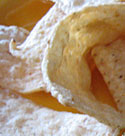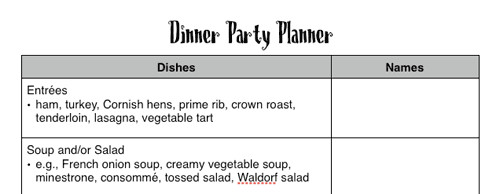I wrote this for my old cooking blog, but I simply must share it again here. If you have never tried the recipe for bean burgers in How to Cook Everything Vegetarian
,
then you are missing out! They are simple to throw together (even in less than 30 minutes); they taste great; the recipe allows for endless variations; they're cheap; and being bean- and oat-based, they're scandalously healthy. You can eat them on bread as burgers, or you can serve them like I generally do, as a substitute for a meat cutlet right on the plate.
Garbanzos make for the best patties in my experience. If you use other beans, be especially careful about the amount of moisture in the mix, adding more oats if necessary to firm it up.
Oh, and as it's just about holiday time, I thought you'd appreciate a glimpse into Slovak holiday traditions. St. Nicholas Day, when presents are exchanged, is past, but the carp is yet to come. I wrote this on New Year's Eve, Dec. 31, 2007.
Meat is a difficult proposition here in Slovakia. Well, at least for me.
The Slovaks are a pork-loving people. I am decidedly anti-pork (with the exception of bacon and occasionally sausage). The Slovaks also are fond of many meats that are uncommon in American supermarkets, such as goose, venison, and duck. I just can't face any new meats.
Not to mention the tradition here of buying a live carp for Christmas dinner, keeping it alive in the bathtub until that fateful supper. Thank goodness those vendors are gone for the year.
Anyway, this long-winded dissection of foreign culinary habits is meant only as a justification for my looking into ways to create protein-packed main dishes without resorting to cultivating a taste for pigeon.
For everyone not living abroad, bean burgers are still a great idea for everyday dinners as they are high in fiber as well as protein and, oh yeah, they're cheap. Even if you do find chicken or ground beef for $3 a pound on sale, it doesn't beat a can of beans at about $0.50 to $1 [more like $1-plus these days, but now, with my slow cooker handy, I can opt for a whole
pound dried for $1.50 - Ed.].
I found this recipe on the site promoting Mark Bittman's
How to Cook Everything series of cookbooks. Specifically, it comes from the new book,
How to Cook Everything Vegetarian, which was on my wish list for this Christmas.
I had an extra can of chickpeas in the cupboard from a side dish I forgot to make, so that became the base for our patties. Because this was the first time I was trying this recipe, I didn't go with any of the suggested variations such as adding cheese (I've made veggie patties from scratch only once in my life, and the result was nearly disastrous).
On the other hand, I didn't have any cheese to add. In fact, after I'd already started adding things to the mixing bowl, I realized that I did not have an egg, either. I'd used the last ones the night before to make French toast, forgetting I was supposed to reserve one. Oops.
I ended up adding a tablespoon of mayonnaise to the mix, figuring that at least that spread contains egg. Bittman does suggest some vegan alternatives for binding, but it seemed odd to add another half-cup of oatmeal and too much trouble to make mashed potatoes or rice from scratch just for this recipe. The mayo turned out to work just fine as a binder, fortunately.
I also had to vary the recipe slightly as far as the method went. I don't have a blender or food processor here, so instead I chopped the onion as finely as I could and then had at the mixture with our potato masher. It took a good bit longer than the food processor would have, but with enough effort it became a uniform mush.
The patties we ended up with perhaps could have used some more seasoning, but we enjoyed them with sauces that provided the extra kick. Scott spread his with ketchup and whole-grain mustard, whereas I dipped mine in tartar sauce as if I were eating
vypražaný syr (fried cheese). We ate them without buns or bread this time, but they are solid enough to be used as hamburger substitutes.
I'm going to try making some with kidney beans soon. And this time, I'm so going to remember the egg.
The Simplest Bean BurgerSource: Mark Bittman,
How to Cook Everything VegetarianYield: 4 to 6 patties
- 2 cups well-cooked white, black, or red beans or chickpeas or lentils, or one 14-ounce can, drained (I used chickpeas/garbanzo beans.)
- 1 medium onion, quartered (I used half a large onion, chopped fine.)
- ½ cup rolled oats (preferably not instant)
- 1 tablespoon chili powder or spice mix of your choice (I used taco seasoning.)
- Salt and freshly ground black pepper
- 1 egg (I used one tablespoon of light mayonnaise.)
- Bean-cooking liquid, stock, or other liquid (wine, cream, milk, water, ketchup, etc.) if necessary (I added a little water.)
- Extra virgin olive oil or neutral oil, like grapeseed or corn, as needed (I used nonstick olive-oil spray.)
1. Combine the beans, onion, oats, chili powder, salt, pepper, and egg in a food processor and pulse until chunky but not puréed, adding a little liquid if necessary (this is unlikely but not impossible) to produce a moist but not wet mixture. Let the mixture rest for a few minutes if time allows.
2. With wet hands, shape into whatever size patties you want and again let rest for a few minutes if time allows. (You can make the burger mixture or even shape the burgers up to a day or so in advance. Just cover tightly and refrigerate, then bring everything back to room temperature before cooking.) Film the bottom of a large nonstick or well-seasoned cast-iron skillet with oil and turn the heat to medium. A minute later, add the patties. Cook until nicely browned on one side, about 5 minutes; turn carefully and cook on the other side until firm and browned.
3. Serve on buns with the usual burger fixings. Or cool and refrigerate or freeze for later use.
Notes:
Simplest Vegan Bean Burger. Many options: Omit the egg, obviously. Add 1/2 cup Mashed Potatoes; or 1/2 cup cooked oatmeal or short-grain rice (white or brown); or 1/4 cup miso or 1/2 cup tofu.
Bean-and-Cheese Burger. As a flavor-adder, cheese can't be beat, plus there are two bonuses: You don't have to mess with melting cheese on top of the burger, and-for the most part-it acts as a binder. Add 1/2 to 1 cup grated Parmesan, cheddar, Swiss, Jack, mozzarella, or other cheese to the mix (you can omit the egg if you like).
Bean-and-Spinach Burger. Of all the veggies you can add to a burger, I like spinach. You can leave it uncooked and just shred it if you prefer (figure about 2 cups), but this gives better results; it's great with a little garlic added: Squeeze dry and chop about 1 cup cooked spinach (you'll need about 8 ounces of raw spinach to start, or you can use frozen spinach); add it to the mix and proceed with the recipe.
Bean-and-Veggie Burger. Many options, but don't overdo it or the burger will fall apart: Add up to 1/2 cup carrots, bell peppers, shallots, leeks, celery, potato, sweet potato, winter squash, zucchini, or a combination. Cut into chunks as you do the onion and grind with the beans or shred or mince and add afterward.
High-Protein Bean Burger. The soy gives it just a little boost: Instead of rolled oats, use rolled soy (soy flakes).
13 Ways to Build Delicious Veggie Burgers
There are more ways to vary the burgers in this section than I can imagine, but here are a few ideas. The basic rules are to make sure the mixture is neither too dry nor too wet (if you find yourself in the first situation, add a liquid ingredient; in the second, add some oats, ground rice powder or flour, cornmeal, flour, bread crumbs, or the like). But as for flavors, the sky's the limit.
1. Fresh herbs. You can almost not go wrong with fresh herbs, as long as you don't use overwhelming amounts. Add up to 1/2 cup parsley, basil, or dill leaves; somewhat less of mint, cilantro, or chervil; a tablespoon of oregano or marjoram; or only a teaspoon or so of fresh thyme, tarragon, or rosemary.
2. Dried herbs. Use by the pinch; to really get the seasoning right, taste and adjust it (you can cook a little bit first if you don't want to taste it raw).
3. Spices. The spice mix-chili or curry powder, for example-is an easy way to go, but you can combine fairly small amounts (usually 1/4 to 1/2 teaspoon) of various spices as you like. Try, for example, smoked paprika, cumin, and ground chiles; coriander, cumin, ginger, and cardamom; or anything else that appeals to you.
4. Garlic. Can't go wrong, really. Add 1 teaspoon or more minced garlic to the mix, or a tablespoon or more Roasted Garlic, with a little of its oil.
5. Chiles. For heat, you can simply add cayenne, hot red pepper flakes, or the like. But if you want some texture, you might include 1/4 cup or more roasted (or canned) green or red chiles.
6. Soy sauce or miso. Just a tablespoon or so of soy sauce, but up to 1/4 cup of any miso; you can omit the egg if you like.
7. Ketchup, salsa, or mustard. Up to 1/3 cup of ketchup or salsa (both of which are pretty good); 1 tablespoon or so of Dijon or other mustard.
8. Nuts or seeds. The nice thing about nuts is the crunch. Add 1/4 cup or so of sesame or sunflower seeds and up to 1/2 cup nuts or pumpkin seeds toward the end of the processing so they don't become too powdery.
9. Lemon, lime, or orange zest. The slight acidity brightens the taste.
10. Tomato paste. A tablespoon or two will give the burgers nice color and a more complex flavor.
11. Mushrooms. Add a tablespoon or so of dried mushrooms, soaked and cooked, as you would any other vegetable (see number 12). Or use up to about 1/2 cup raw, trimmed and added along with the oats and beans.
12. Cooked veggies. Milder flavor, softer texture than raw veggies: Add up to a cup of cooked vegetables- onions, greens, broccoli, potatoes, sweet potatoes, winter squash, zucchini-whatever you like. If you use potatoes and add them to the food processor along with the beans, you can omit the egg and oats.
13. Cooked grains. All-grain burgers tend to be mushy and uninteresting, but adding a bit of grains to other burgers results in a terrific light texture. Feel free to add up to a cup of cooked grains, along with the beans. Omit the oats and, if you like, the egg.




























 Have you seen TLC's new "Family Night" show,
Have you seen TLC's new "Family Night" show, 
 A member of my family is on a doctor-recommended diet to lose weight and prevent the onset of type 2 diabetes. Basically, the doctor told this person to avoid all white foods: white bread, sugar, and potatoes. It's a simplified version of the low-glycemic, South Beach-style of eating.
A member of my family is on a doctor-recommended diet to lose weight and prevent the onset of type 2 diabetes. Basically, the doctor told this person to avoid all white foods: white bread, sugar, and potatoes. It's a simplified version of the low-glycemic, South Beach-style of eating. FYI, for a tasty low-fat Christmas cookie recipe, check out
FYI, for a tasty low-fat Christmas cookie recipe, check out 

 A new and interesting offering today!
A new and interesting offering today!

